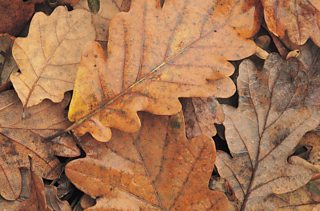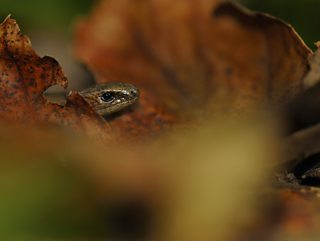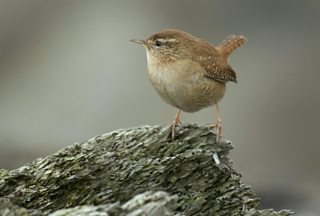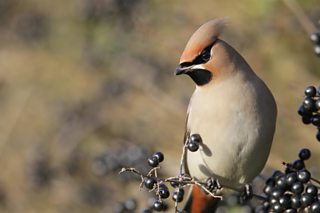Jamie Wyver from the gives you five top tips to give nature a home through the chillier months ahead.
Autumn is coming to an end, and as the morning fog clears it might seem that the colour is draining from your garden. But don’t give up: from now on your patch will provide a lifeline to birds and other animals seeking food, water and shelter over winter. One of the great joys of attracting wildlife to your garden in winter is that as well as improving their chances for survival, you’re gaining a deeper understanding of the needs and behaviour of the birds, mammals, invertebrates and others that drop in. A little effort now will bring endless moments of pleasure over winter as wild visitors bring life to your backyard.

Credit: Andy Hay
Don’t be too tidy
As a gardener I instinctively want to clear up after the ‘growing season’. But it’s worth remembering that excessive pruning now will reduce the amount of useful shelter for wildlife during the colder months. So, see if you can live with a little untidiness particularly where thicker shrubs, evergreens or climbers are concerned. Under the ivy, for example, there are handy little reservoirs of insects for birds like dunnocks, robins and wrens to fall back on when everywhere is frozen. Seedheads of numerous garden plants are great for finches, so don’t deadhead your alliums, crocosmias, honesty and sea hollies. Small mammals, including hedgehogs, love a good tussock: is there a corner of your lawn or patch of a flowerbed that you can leave untouched, with plenty of dense cover at ground level?
If there are any berry bearing hedges or trees (like hawthorn, rowan, holly or elder) make sure any cutting work is left until the berry crop has been eaten by the wintering birds. It’s also worth remembering that if you’re planning a bonfire, what seems like a pile of sticks to us looks like a perfect bedroom to amphibians, reptiles, hedgehogs and others. You can avoid harming hibernating animals by moving your bonfire materials on the day you plan to light them, giving you an opportunity to check for wildlife and the animals a chance to escape.

Starlings are regular visitors to many gardens, and can appear in large numbers. Credit: Andy Hay
Leave some leaves
By now there will be plenty of leaf litter scattered over the ground. Many gardeners feel it looks messy, but again this can harbour insects and other invertebrates: and these are good for blackbirds, dunnocks and others. Hedgehogs root around in leaf litter before they hibernate, and toads and newts will use it for shelter. Your friendly garden earthworms will be on hand to help break down the leaf material, benefitting your soil and therefore lawns and plants in years to come. If you want to be a little bit tidy you could rake the leaves into a quiet corner or into the borders: leaf mulch makes great compost!

Slow worms are actually legless lizards, and love a good compost heap. Credit: Ben Andrew
Nestbox makeover
By the time the first snowflake lands it’s a good idea to provide a cosy place for small birds such as wrens to keep warm. Nestboxes, which may have hosted families of birds throughout the summer, will often be used as snug communal shelters during the colder months. Nests can house parasites such as fleas, lice and ticks, as well as fungi which will thrive in damp conditions. You can help by removing old nesting material to keep the box fresh and hygienic. When you do this, it’s a good idea to don a pair of gloves to protect your hands and wear a face mask to avoid breathing in dust from feathers and dry nest materials. If you find any unhatched eggs – it’s perfectly normal for some to fail – remove those too. You should remove the eggs somewhere in between 1 September and 31 January - outside the breeding season (removal outside of this period is classed as a criminal offence). Compost the old nest or leave it under a hedge to decompose, then use boiling water to kill off any remaining parasites in the box. Leave it open until it has thoroughly dried out. Then place a handful of hay (but not straw), wood chippings or cosy nesting wool in the box.

Wrens will often use nest boxes to roost in during cold winters, and will often gather together to stay warm. Credit: John Bridges
Water supply
Out in the chilly, misty countryside in the depths of winter, everything is under ice. We’ve heard of various tricks to keep a supply of unfrozen water in the garden. The best seems to be to float a small light object, such as a ping pong ball, on the surface of the water so that the gentlest breeze will keep it moving and slow the freezing process. I change the water in my birdbath every morning to make sure it’s clean too. Alternatively, you could empty the water in the evenings where a hard frost is forecast and fill it again in the morning. All birds need to drink everyday so it’s vital through the winter that they can access water. Bathing even in freezing temperatures is important to birds for keeping their feathers in good condition, maximising heat retention.

Waxwings are a rare winter migrant to Britain, and are a real treat for any wildlife gardener. Credit: Andy Hay
Plant a tree (or two. Or three.)
This is really planning a little further ahead, for winters to come. Deciduous trees are dormant (and can be cheaper) right now so it’s a good time to get planting. We’re encouraging people to choose native species like hawthorn, alder buckthorn, purging buckthorn, spindle and wild privet, whose fruit provide a feast for thrushes, blackcaps and others. My favourite is the rowan (or mountain ash) which really has the ‘wow factor’ with its pendulous bunches of bright berries: a great draw for winter birds, including the potential to bring in a real star of winter, the waxwing. You could also think about growing trees and shrubs that will provide for you as well as wildlife: apples, crab apples, pears and hazel, for your own autumnal treats. Starlings, who provide the most stunning aerial displays in winter, will also appreciate fallen fruit. As the trees develop there will be more than enough for you and for your garden wildlife. Of course these trees will offer nesting sites in the spring, and will also attract insects which in turn feed our garden favourites like the blue tit and house sparrow.
Sit back and enjoy the fruits of your labour.
Remember that on 30 and 31 January 2016 you can take part in our annual Big Garden Birdwatch. Contribute to one of the UK’s biggest citizen science project by settling down with a cup of tea and, if available, smaller family member or dozing pet sat in your lap, and watch your garden for an hour to see what turns up. Find out more here:
There’s more information on giving nature a home in your garden here:
